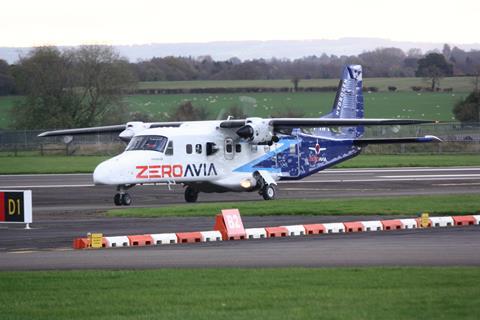Hydrogen-powertrain developer ZeroAvia has joined French company Absolut Hydrogen to tackle tricky challenges associated with widespread adoption by the aviation industry of ultra-cold liquid-hydrogen fuel.
The firms have partnered to develop the “liquid-hydrogen refueling infrastructure” that the aerospace sector would need should it transition, as ZeroAvia hopes, to using hydrogen fuel.
“The partners will work together to build and demonstrate liquefaction and liquid hydrogen storage in an airport context,” ZeroAvia and Absolut say on 17 April.

They will also “explore” a hydrogen “concept of operations, safety procedures and standards for larger-scale deployment to deliver liquid hydrogen to aircraft”.
Hydrogen must be kept extremely cold – below -253°C (-423°F) – to remain a liquid, posing problems for aerospace and other applications.
Absolut Hydrogen, a subsidiary of Groupe Absolut, sells liquid-hydrogen storage tanks, refuelling systems and “thermal management” technologies. Its parent has experience developing “customised cryogenic equipment”.
“It has been critical to establish partnerships to begin building the ecosystem that can deliver liquid hydrogen fuel for larger aircraft at larger airport locations,” says ZeroAvia vice-president of infrastructure Arnab Chaterjee.
ZeroAvia, with operations in the UK and USA, is among several start-ups betting that the aviation industry, in its quest to cut carbon emissions, will embrace hydrogen fuel, which emits only water when burned or used to produce electricity. Another player is Universal Hydrogen.
ZeroAvia has already been flying a Dornier 228 powered partly by its 600kW ZA600 – a hydrogen-fuel-cell propulsion system that generates electricity from hydrogen gas.
ZeroAvia, which replaced the 228’s port-side Honeywell TPE331 turboprop with a ZA600, aims for that powertrain to enter service in 2025 on aircraft with less than 20 seats.
At the same time, ZeroAvia is developing a more-powerful propulsion system requiring liquid hydrogen – its 2-5.4MW ZA2000. That powertrain will be suited for aircraft with 40 to 80 seats – like regional turboprops and regional jets – and will enter service in 2027, ZeroAvia says.
Liquid hydrogen improves “the volumetric energy density of the fuel, enabling support for larger aircraft flying more passengers on longer typical routes”, it adds.
“I am convinced this partnership will lead to new standards on liquid hydrogen infrastructure for aircrafts,” says Absolut Hydrogen chief executive Jerome Lacapere.
Airbus has also thrown its support behind hydrogen, having in recent years released several concepts of hydrogen-based airliners. Boeing, however, has been less energetic about such designs.
US firm Universal Hydrogen made news in March when it completed first flight of a De Havilland Canada Dash 8-300 powered partly by a hydrogen-fuel-cell system. Universal is developing a system for transporting hydrogen designed around tanks called “modules” that can be swapped into and out of aircraft.


























